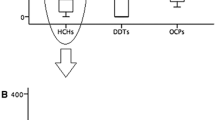Abstract
One hundred healthy Turkish volunteers (70 male, 30 female) aged from 19 to 56 years were given 5 mg coumarin p.o. after an overnight fast. Urine samples were collected before and 2, 4 and 8 h after drug administration. The extent and rate of formation of 7-OH-coumarin (7OHC) was determined by the urinary excretion of the metabolite as measured with the fluorometric method.
On average, 80% of 7OHC formed was excreted in 2 h. The total amount of 7OHC formed was 59.8% (21.5%) (mean and SD, n=100, range 17–100%) of the given dose. The percentage of 7OHC excreted during the first 2 h compared with the 7OHC excretion at 8 h was a constant and stable individual characteristic for the rate of the formation of 7OHC (‘2 h coumarin test’).
Although four individuals had relatively slow coumarin test values (34–40%), no clear-cut polymorphism in the rate of 7OHC formation was found. However, 7OHC formation was lower in males and in cigarette smokers.
Similar content being viewed by others
References
Egan D, O'Kennedy R, Moran E, Cox D, Prosser E, Thornes RD (1990) The pharmacology, metabolism, analysis, and applications of coumarin and coumarin-related compounds. Drug Metab Rev 22: 503–529
Moran E, O'Kennedy R, Thornes RD (1987) Analysis of coumarin and its urinary metabolites by high-performance liquid chromatography. J Chromatogr 416: 165–169
Raunio H, Kojo A, Juvonen R, Honkakoski P, Jarvinen P, Lang MA, Vahakangas K, Gelboin HV, Park SS, Pelkonen O (1988) Mouse hepatic cytochrome P-450 isozyme induction by 1,4-bis 2-(3,5-dichloropyridyloxy) benzene, pyrazole, and phenobarbital. Biochem Pharmacol 37: 4141–4147
Nebert DW, Nelson DR, Coon MR, Estabrook RW, Feyereisen R, Fujii-Kuriyama Y, Gonzales FJ, Guengerich FP, Gunsalus IC, Johnson EF, Loper JC, Sato R, Waterman MR, Waxman DJ (1991) The P450 superfamily: update on new sequences, gene mapping and recommended nomenclature. DNA Cell Biol 10: 1–14
Ritschel WA, Brady ME, Tan HSI, Hoffmann KA, Yiu IM, Grummich KW (1977) Pharmacokinetics of coumarin and its 7-hydroxy-metabolites upon intravenous administration of coumarin in man. Eur J Clin Pharmacol 12: 457–461
Ritschel WA, Brady ME, Tan HSI (1979) First-pass effect of coumarin in man. Int J Clin Pharmacol Biopharm 17: 99–103
Wood AW, Conney AH (1974) Genetic variation in coumarin hydroxylase activity in the mouse (Mus musculus). Science 185: 612–614
Lush IE, Andrews KM (1978) Genetic variation between mice in their metabolism of coumarin and its derivatives. Genet Res Camb 31: 177–186
Wood AW (1979) Genetic regulation of coumarin hydroxylase activity in mice. Biochemical characterization of the enzyme from two inbred strains and their F1 hybrid. J Biol Chem 254: 5641–5646
Lang MA, Juvonen R, Jarvinen P, Honkakoski P, Raunio H (1989) Mouse liver P450coh: genetic regulation of the pyrazole-inducible enzyme and comparison with other P450 isozymes. Arch Biochem Biophys 271: 139–148
Pelkonen O, Sotaniemi EA, Ahokas JT (1985) Coumarin 7-hydroxylase activity in human liver microsomes. Properties of the enzyme and interspecies comparisons. Br J Clin Pharmacol 19: 59–66
Miles JS, McLaren AW, Forrester LM, Glancey MJ, Lang MA, Wolf CR (1990) Identification of the human liver cytochrome P-450 responsible for coumarin 7-hydroxylase activity. Biochem J 267: 365–371
Yamano S, Tatsuno HJ, Gonzales FJ (1990) The CYP2A3 gene product catalyzes coumarin 7-hydroxylation in human liver microsomes. Biochemistry 29: 1322–1329
Rautio A, Holger K, Kojo A, Salmela E, Pelkonen O (1992) Interindividual variability of coumarin 7-hydroxylation in healthy volunteers. Pharmacogenetics 2: 227–233
Cholerton S, Idle ME, Vas A, Gonzales FJ, Idle JR (1992) Comparison of a novel thin-layer chromatographic-fluorescence detection method with a spectrofluorometric method for the determination of 7-hydroxycoumarin in human urine. J Chromatogr 575: 325–330
Kalow W (1982) Ethnic differences in drug metabolism. Pharmacokinetics 7: 373–391
Negishi M, Lindberg R, Burkhart B, Ichikawa T, Honkakoski P, Lang M (1989) Mouse steroid 15α-hydroxylase gene family: identification of type II P-45015α as coumarin 7-hydroxylase. Biochemistry 28: 4169–4172
Maenpaa J (1993) Human P450 isoform assignment by antibodies and inhibitors PhD thesis (Acta Univ Oulu D 285), University of Oulu, Finland
Author information
Authors and Affiliations
Additional information
The scientific contents of this paper contribute to the goals of the COST B1 project.
Rights and permissions
About this article
Cite this article
Iscan, M., Rostami, H., Güray, T. et al. Interindividual variability of coumarin 7-hydroxylation in a Turkish population. Eur J Clin Pharmacol 47, 315–318 (1994). https://doi.org/10.1007/BF00191161
Received:
Accepted:
Issue Date:
DOI: https://doi.org/10.1007/BF00191161




